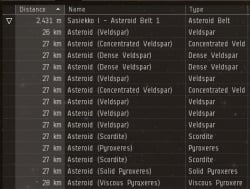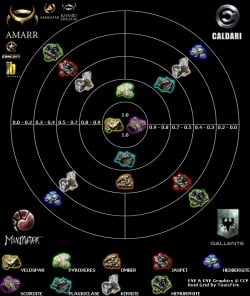Difference between revisions of "User:Shintu felper"
(Blanked the page) |
|||
| Line 1: | Line 1: | ||
| + | == Asteroid distribution == | ||
| + | [[File:Glow_roid_grid.jpg|thumb|250px|right|Asteroid distribution]] | ||
| + | [[File:Asteroid-belt-overview.jpg|thumb|250px|right|An asteroid belt, as seen on the [[overview]]. Note the belt's warp-in point (marked with an inverted triangle), as well as the variety of different asteroid types (all labelled according to what kind of ore they contain).]] | ||
| + | {{hatnote|For the distribution of ice asteroids, see [[Ice harvesting#Ice distribution|Ice distribution]].}} | ||
| + | The EVE universe can be divided into [[topology|four quarters]]: | ||
| + | * The Amarr quarter (includes systems held by the Amarr, Ammatar, Khanid, Blood Raiders, and Sansha's Nation) | ||
| + | * The Caldari quarter (includes systems held by the Caldari and Guristas) | ||
| + | * The Gallente quarter (includes systems held by the Gallente and Serpentis) | ||
| + | * The Minmatar quarter (includes systems held by the Minmatar and Angel Cartel) | ||
| + | Each of these four quarters has its own set of asteroid types. Additionally, the lower the [[Security Rating|security rating]] of a system, the rarer the asteroid types that can be found there. Finally, each system can also include all the asteroid types of same-quarter higher-security systems. For example, a Gallente system with a security rating of 0.7 will have asteroid belts with not only Omber asteroids, but also Veldspar, Scordite, and Plagioclase asteroids. | ||
| + | |||
| + | {| class="wikitable" style="font-size:90%;" | ||
| + | |- | ||
| + | ! style="background:#222222;" rowspan=2 | System<br>security<br>rating | ||
| + | ! style="background:#222222;" colspan=4 | Quarter | ||
| + | |- | ||
| + | ! style="background:#222222;" | {{icon|amarr|64|Amarr quarter}} | ||
| + | ! style="background:#222222;" | {{icon|caldari|64|Caldari quarter}} | ||
| + | ! style="background:#222222;" | {{icon|gallente|64|Gallente quarter}} | ||
| + | ! style="background:#222222;" | {{icon|minmatar|64|Minmatar quarter}} | ||
| + | |- | ||
| + | | {{co|#2FEFEF|█}} 1.0 and lower | ||
| + | | {{icon|veldspar|32|Veldspar}} Veldspar<br>{{icon|scordite|32|Scordite}} Scordite | ||
| + | | {{icon|veldspar|32|Veldspar}} Veldspar<br>{{icon|scordite|32|Scordite}} Scordite | ||
| + | | {{icon|veldspar|32|Veldspar}} Veldspar<br>{{icon|scordite|32|Scordite}} Scordite | ||
| + | | {{icon|veldspar|32|Veldspar}} Veldspar<br>{{icon|scordite|32|Scordite}} Scordite | ||
| + | |- | ||
| + | | {{co|#48F0C0|█}} 0.9 and lower | ||
| + | | {{icon|pyroxeres||Pyroxeres}} Pyroxeres | ||
| + | | {{icon|pyroxeres||Pyroxeres}} Pyroxeres | ||
| + | | {{icon|plagioclase||Plagioclase}} Plagioclase | ||
| + | | {{icon|plagioclase||Plagioclase}} Plagioclase | ||
| + | |- | ||
| + | | {{co|#00F000|█}} 0.7 and lower | ||
| + | | {{icon|kernite||Kernite}} Kernite | ||
| + | | {{icon|plagioclase||Plagioclase}} Plagioclase | ||
| + | | {{icon|omber||Omber}} Omber | ||
| + | | {{icon|omber||Omber}} Omber | ||
| + | |- | ||
| + | | {{co|#D77700|█}} 0.4 and lower | ||
| + | | {{icon|jaspet||Jaspet}} Jaspet | ||
| + | | {{icon|kernite||Kernite}} Kernite | ||
| + | | {{icon|jaspet||Jaspet}} Jaspet | ||
| + | | {{icon|kernite||Kernite}} Kernite | ||
| + | |- | ||
| + | | {{co|#F04800|█}} 0.2 and lower | ||
| + | | {{icon|hemorphite||Hemorphite}} Hemorphite | ||
| + | | {{icon|hedbergite||Hedbergite}} Hedbergite | ||
| + | | {{icon|hemorphite||Hemorphite}} Hemorphite | ||
| + | | {{icon|hedbergite||Hedbergite}} Hedbergite | ||
| + | |- | ||
| + | | {{co|#F00000|█}} 0.0 and lower | ||
| + | | {{icon|spodumain||Spodumain}} Spodumain<br>{{icon|gneiss||Gneiss}} Gneiss<br>{{icon|crokite||Crokite}} Crokite<br>{{icon|arkonor||Arkonor}} Arkonor<br>{{icon|bistot||Bistot}} Bistot<br>{{icon|mercoxit||Mercoxit}} Mercoxit | ||
| + | | {{icon|dark ochre||Dark Ochre}} Dark Ochre<br>{{icon|crokite||Crokite}} Crokite<br>{{icon|spodumain||Spodumain}} Spodumain<br>{{icon|bistot||Bistot}} Bistot<br>{{icon|mercoxit||Mercoxit}} Mercoxit | ||
| + | | {{icon|dark ochre||Dark Ochre}} Dark Ochre<br>{{icon|crokite||Crokite}} Crokite<br>{{icon|arkonor||Arkonor}} Arkonor<br>{{icon|bistot||Bistot}} Bistot<br>{{icon|mercoxit||Mercoxit}} Mercoxit | ||
| + | | {{icon|spodumain||Spodumain}} Spodumain<br>{{icon|gneiss||Gneiss}} Gneiss<br>{{icon|arkonor||Arkonor}} Arkonor<br>{{icon|bistot||Bistot}} Bistot<br>{{icon|mercoxit||Mercoxit}} Mercoxit | ||
| + | |} | ||
| + | |||
| + | In general, the rarer the ore, the higher its volume per unit (e.g. one unit of Veldspar has a volume of 0.1 m<sup>3</sup>, whereas one unit of Arkonor has a volume of 16 m<sup>3</sup>). Since mining lasers mine a given ''volume'' of ore per minute, it takes longer to mine the rarer ore types. Additionally, each ore reprocesses into a different set of minerals. For details, see [[Reprocessing]]. | ||
| + | |||
| + | Note that mining Mercoxit requires the {{sk|Deep Core Mining}} skill as well as [[ORE Basic Ship and Skill Guide#High-slot modules|special mining modules]] (Deep Core Miners or Deep Core Strip Miners). All other ore types can be mined with all types of ore mining lasers or strip miners. | ||
Revision as of 16:10, 12 July 2018
Asteroid distribution

- For the distribution of ice asteroids, see Ice distribution.
The EVE universe can be divided into four quarters:
- The Amarr quarter (includes systems held by the Amarr, Ammatar, Khanid, Blood Raiders, and Sansha's Nation)
- The Caldari quarter (includes systems held by the Caldari and Guristas)
- The Gallente quarter (includes systems held by the Gallente and Serpentis)
- The Minmatar quarter (includes systems held by the Minmatar and Angel Cartel)
Each of these four quarters has its own set of asteroid types. Additionally, the lower the security rating of a system, the rarer the asteroid types that can be found there. Finally, each system can also include all the asteroid types of same-quarter higher-security systems. For example, a Gallente system with a security rating of 0.7 will have asteroid belts with not only Omber asteroids, but also Veldspar, Scordite, and Plagioclase asteroids.
In general, the rarer the ore, the higher its volume per unit (e.g. one unit of Veldspar has a volume of 0.1 m3, whereas one unit of Arkonor has a volume of 16 m3). Since mining lasers mine a given volume of ore per minute, it takes longer to mine the rarer ore types. Additionally, each ore reprocesses into a different set of minerals. For details, see Reprocessing.
Note that mining Mercoxit requires the Deep Core Mining skill as well as special mining modules (Deep Core Miners or Deep Core Strip Miners). All other ore types can be mined with all types of ore mining lasers or strip miners.




